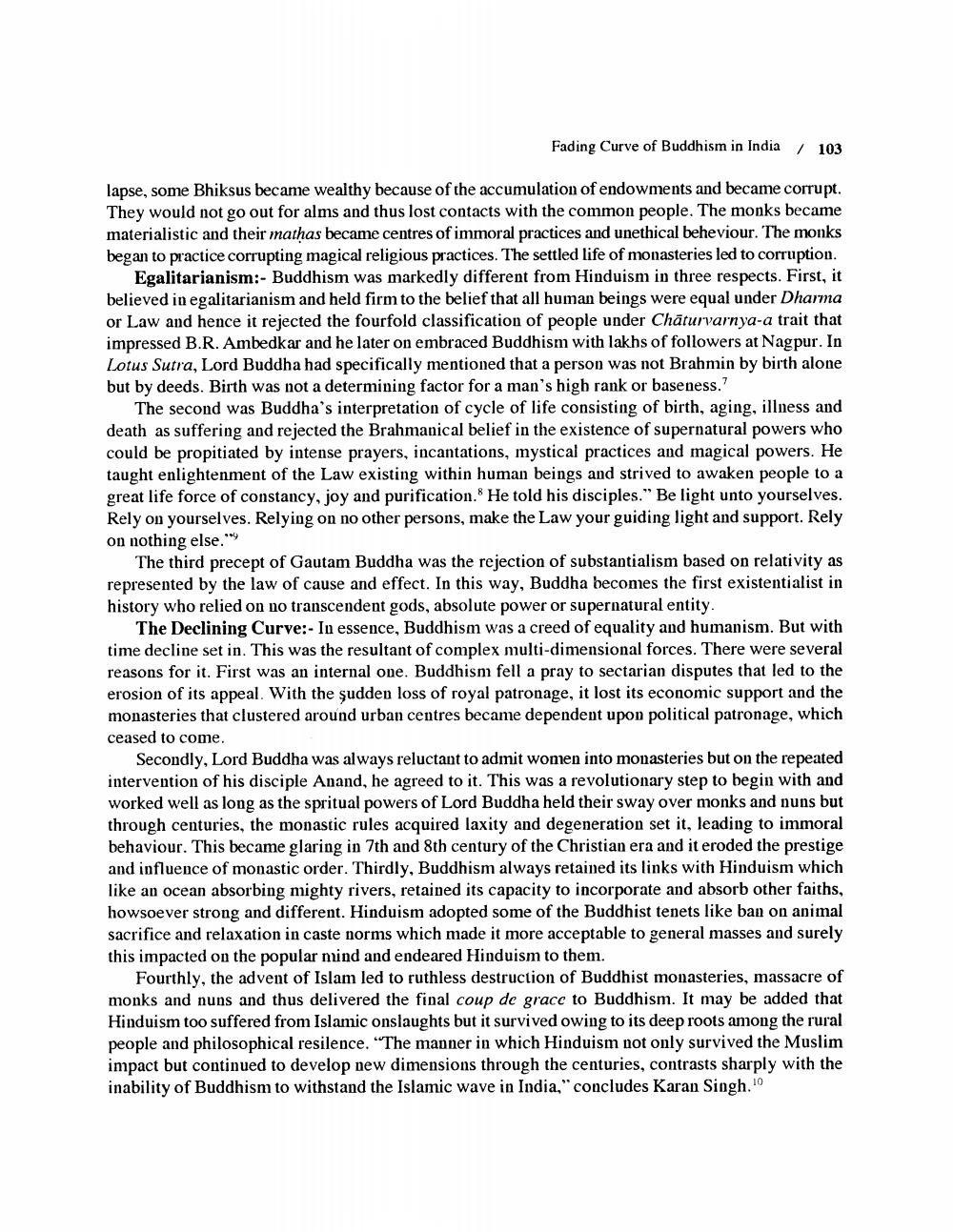________________
Fading Curve of Buddhism in India
/ 103
lapse, some Bhiksus became wealthy because of the accumulation of endowments and became corrupt. They would not go out for alms and thus lost contacts with the common people. The monks became materialistic and their mathas became centres of immoral practices and unethical beheviour. The monks began to practice corrupting magical religious practices. The settled life of monasteries led to corruption.
Egalitarianism:- Buddhism was markedly different from Hinduism in three respects. First, it believed in egalitarianism and held firm to the belief that all human beings were equal under Dharma or Law and hence it rejected the fourfold classification of people under Chāturvarnya-a trait that impressed B.R. Ambedkar and he later on embraced Buddhism with lakhs of followers at Nagpur. In Lotus Sutra, Lord Buddha had specifically mentioned that a person was not Brahmin by birth alone but by deeds. Birth was not a determining factor for a man's high rank or baseness.?
The second was Buddha's interpretation of cycle of life consisting of birth, aging, illness and death as suffering and rejected the Brahmanical belief in the existence of supernatural powers who could be propitiated by intense prayers, incantations, mystical practices and magical powers. He taught enlightenment of the Law existing within human beings and strived to awaken people to a great life force of constancy, joy and purification. He told his disciples." Be light unto yourselves. Rely on yourselves. Relying on no other persons, make the Law your guiding light and support. Rely on nothing else."
The third precept of Gautam Buddha was the rejection of substantialism based on relativity as represented by the law of cause and effect. In this way, Buddha becomes the first existentialist in history who relied on no transcendent gods, absolute power or supernatural entity
The Declining Curve:- In essence, Buddhism was a creed of equality and humanism. But with time decline set in. This was the resultant of complex multi-dimensional forces. There were several reasons for it. First was an internal one. Buddhism fell a pray to sectarian disputes that led to the erosion of its appeal. With the sudden loss of royal patronage, it lost its economic support and the monasteries that clustered around urban centres became dependent upon political patronage, which ceased to come.
Secondly, Lord Buddha was always reluctant to admit women into monasteries but on the repeated intervention of his disciple Anand, he agreed to it. This was a revolutionary step to begin with and worked well as long as the spritual powers of Lord Buddha held their sway over monks and nuns but through centuries, the monastic rules acquired laxity and degeneration set it, leading to immoral behaviour. This became glaring in 7th and 8th century of the Christian era and it eroded the prestige and influence of monastic order. Thirdly, Buddhism always retained its links with Hinduism which like an ocean absorbing mighty rivers, retained its capacity to incorporate and absorb other faiths, howsoever strong and different. Hinduism adopted some of the Buddhist tenets like ban on animal sacrifice and relaxation in caste norms which made it more acceptable to general masses and surely this impacted on the popular mind and endeared Hinduism to them.
Fourthly, the advent of Islam led to ruthless destruction of Buddhist monasteries, massacre of monks and nuns and thus delivered the final coup de grace to Buddhism. It may be added that Hinduism too suffered from Islamic onslaughts but it survived owing to its deep roots among the rural people and philosophical resilence. "The manner in which Hinduism not only survived the Muslim impact but continued to develop new dimensions through the centuries, contrasts sharply with the inability of Buddhism to withstand the Islamic wave in India," concludes Karan Singh."




